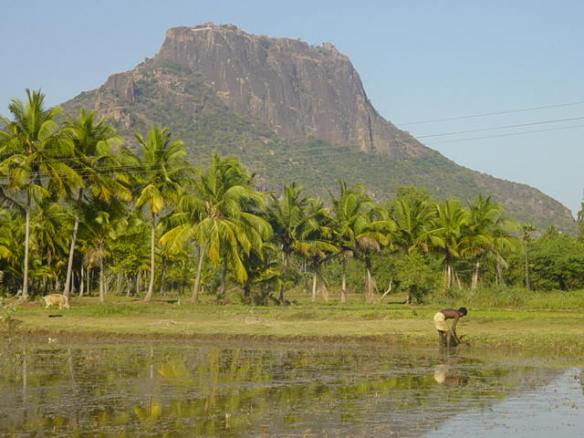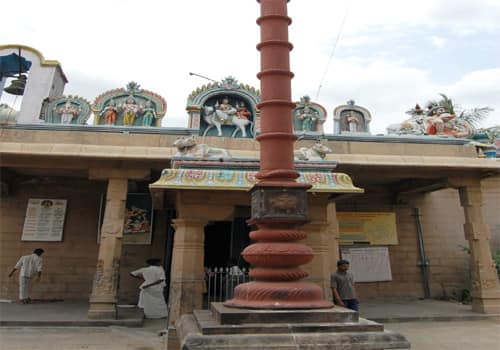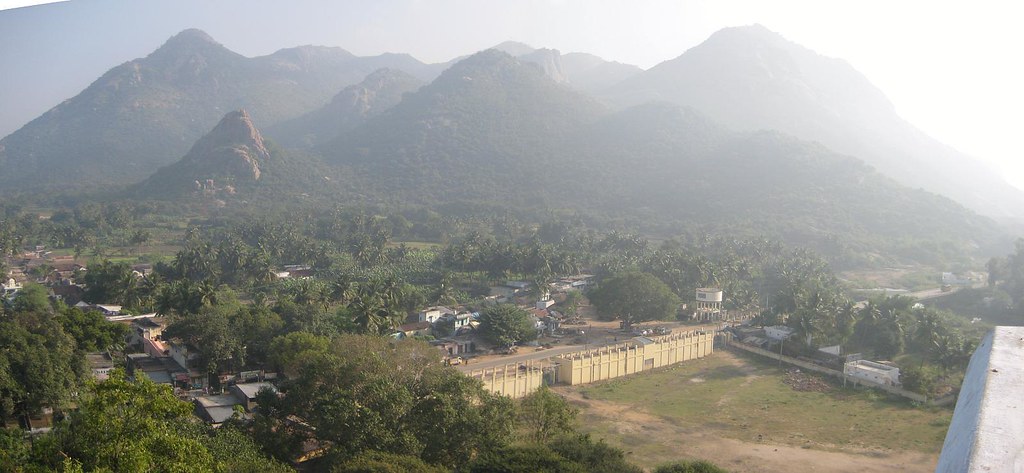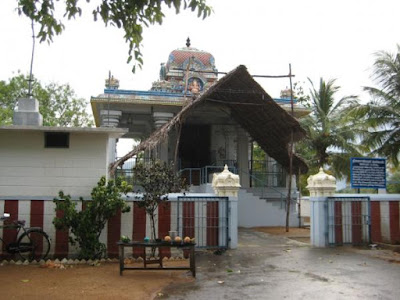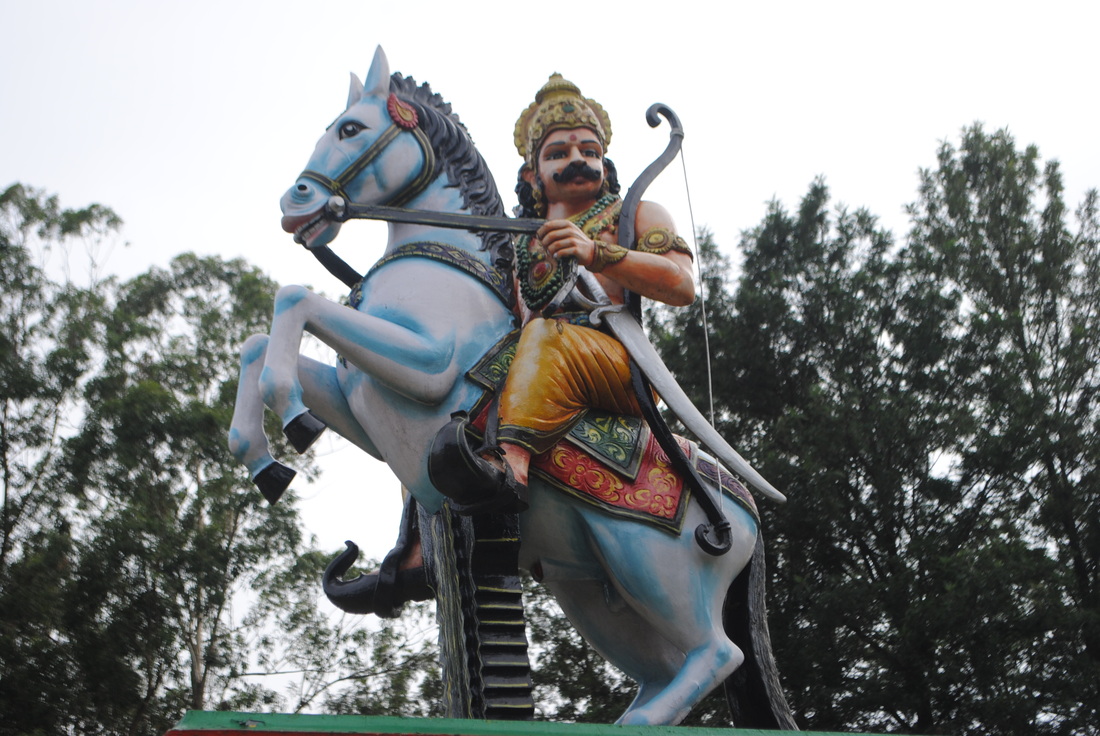
Kolli Hills (கொல்லி மலை), the "Mountains of Death," is a small mountain range located in Kollimalai taluk, Namakkal district, Tamil Nadu, India. Most parts of the Kolli hills are located in Namakkal district and few parts are situated in Tiruchirapalli district. The Kolli Hills forms part of the Eastern Ghats. It is also forming part of the Trichy & Namakkal Forest Division of Tamil Nadu. The geographical coordinates of Kolli mountain ranges are 10°12' - 11°7'N latitude and 76° - 77°56'E longitude and the hill is 305 m (1000 feet) high from sea level and spans an area of 280 sq.km. It is located 24 km towards east from Namakkal, 27.4 km from Rasipuram, 40 km from Karur, 53 km from Salem, 67 km from Attur, 107 km from Tiruchirapalli, 200 km from Coimbatore, 258 km from Banagluru and 331 km from Chennai. There are several villages located in this hill range. The postal head office is Semmedu PIN code 637411 and the village comes under Valavanthi Nadu Panchayat. This popular village in Kolli hills has few shops, hotels, primary health center and telephone exchange. Also there is a statue of Valvil Ori, renowned Sangam chieftain. Namagiripettai, Thammampatti, Namakkal and Rasipuram are the nearby towns to Kolli Hills.
Tourist Attractions
Tourist Attractions
Kolli Hills is an unspoilt , unknown Hill station with a pleasant cool climate which never rises above 30ºC or falls below 13ºC. It is one of the few places that still retains its natural beauty and is untouched by commercial activities and exploitation. Located on the Eastern Ghats, Kolli Hills offers the most splendid of the surrounding greenery. It is an ideal nature's retreat for tourists and locals. It has 72 hair pen bends to reach the top of the hills. To enjoy the salubrious climate plan a holiday to this nature’s destination soon.
The Kollihills is connected by road and you can easily reach there from Namakkal or Salem or Attur. Nowadays the Bus service is provided up to Arappaleeswarar Temple. BSNL (earlier DOT) established the first Telecommunication networks (LDPCO) in 1977 and afterwards the Telecom facilities are continuously expanded depending upon the requirements at Kolli hills.
Kolli Hills attractions include the spectacular Agasagangai water falls, Arappaleeswarar temple, and Ettukkai Amman temple. The hill also has spectacular view points and the visitors should not miss while at this hills. They include Belukurichi tract, Hairpin Bend view points at 34, 35, 37, Masilla falls, Namma Falls, Boat House and State Botanical Garden. Get clear views of valley side at Sirumalai View Point, Selur Wireless view point, Seekuparai viewpoint and Binnam View Point. Other favorite destinations could be the ancient ruins of Britisher Bungalow, Wood House & Jain statue and Puranikadu Sat Dharma sangam ashram
| Agasagangai Waterfalls PC: Wikimedia |
Agasagangai: Agasagangai, the waterfall of the Aiyaru river, is truly the spectacular sight as the water cascades down from 300 feet, covering all around. The visitor needs to climb down the 1000 and odd steps along the mountain edge leading to the waterfalls. It is very close to Arapaleeswarar temple.
Arapaleeswarar temple: The Arapaleeswarar Temple, dedicated to Lord Shiva, is popularly believed to have been built by Valvil Ori around first or second century A.D. The temple is located in Periyakoviloor close to Agasagangai waterfall. The temple bear inscriptions dating back to the Chola period. Megalithic burial site was also discovered closer to the temple.
Siddha Caves: It is widely believed that Tamil Siddhars (yogic saints) dwell in this hill. They are known for their alchemy and knowledge over medicinal herbs. Some of the important herbs found in this hill include Jothippul (ஜோதிப்புல்), Saynthadum Pavai (சாய்ந்தாடும் பாவை), Amala (black species) (கருநெல்லி), Red Aloe vera (சிவப்பு கற்றாழை), Black Banana (கருவாழை), Red Myrobalan (சிவப்புக் கடுக்காய்), Roma Virutcham (ரோம விருட்சம்) etc.,The caves of Bogar and Agastya are situated near the Agasagangai waterfalls, while Korakka Siddha and Kalaanginatha Siddhais deep inside the forest area
Semmedu: Popularly known village to locals and is located on the main road leading to hill summit. At Semmedu the state government organizes Valvil Ori Cultural and Tourism Festival in August. The festival is being organized during August, since people from 16 villages used to assemble together to celebrate Adi (Tamil month) festival during Valvil Ori's rule.
Vaasaloorpatti: An important village on the main road. The village houses the Government Fruit Farm. is located. Paddy varieties are cultivated in the valley and a variety of hybrid and native fruits such as banana, jack fruit, oranges, coffee, pepper and spices are grown on the slopes here.
Solakkadu: Solakkadu is another important village and one of the highest points in the hills and is. located on the main road leading to hill summit. The spectacular viewpoint inside the Highways Bungalow premises is worth visiting.
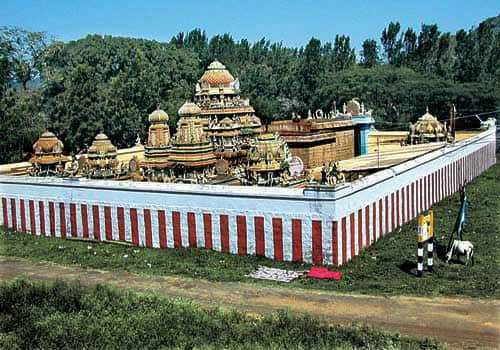 |
| Arappaleeswarar Temple PC: Dinamalar |
Semmedu: Popularly known village to locals and is located on the main road leading to hill summit. At Semmedu the state government organizes Valvil Ori Cultural and Tourism Festival in August. The festival is being organized during August, since people from 16 villages used to assemble together to celebrate Adi (Tamil month) festival during Valvil Ori's rule.
Vaasaloorpatti: An important village on the main road. The village houses the Government Fruit Farm. is located. Paddy varieties are cultivated in the valley and a variety of hybrid and native fruits such as banana, jack fruit, oranges, coffee, pepper and spices are grown on the slopes here.
Solakkadu: Solakkadu is another important village and one of the highest points in the hills and is. located on the main road leading to hill summit. The spectacular viewpoint inside the Highways Bungalow premises is worth visiting.
Kollippavai “Maiden of death”
Sangam literature vividly depicts the lofty peaks of Kolli hills covered with clouds. Due to abundant rainfall Kolli Hill is blessed with fragrant flowers like iruvatchi, jasmine and kanthal. Kolli Hills is known for the special variety of paddy grown here.
Kolli Hills is believed to have by Kollipavai ("Maiden of death"), the local deity. The legend states that the sages chose Kolli hills for a peaceful place to do their penance. Despite, the demons marched aggressively to the hills to interrupt the penance. The sages invoked the goddess Kollipavai to save their rituals. The goddess became ferocious and annihilated the demons. The goddess Kollipavai is still being worshiped here as Ettukai Amman by the people in Kolli hills and her smile is revered by the locals. Ettukai Amman Temple is an ancient temple located four km from Kolli Hills. The small temple, a palm leaf hut not protected by doors, attracts numerous pilgrims on Amavasai or no moon days. The idol appear with eight hands and hence the name Ettu Kai amman (Goddess with eight hands). The ideal is often covered with sandal paste to cool the ferociousness.
 |
| Ettukkai Amman Temple PC: Hindu Blog |
பெரும் பூண் பொறையன் பேஎமுதிர் கொல்லிக்
கருங்கண் தெய்வம் குட வரை எழுதிய
நல் இயல் பாவை அன்ன... ...
Kurunthokai 89: 4 - 7, Paranar,
What the heroine’s friend said to her, as the hero listened nearby: My friend with delicate features, like the fine goddess, painted by a fierce, ancient, black-eyed god on the west side of Kolli Mountain
of Poraiyan with heavy jewels! (Poraiyan is a name used for the Chera kings).
... ... ... ... ... ... ... ... ... ... ... ... ... ... ... குட்டுவன்
குட வரைச் சுனைய மா இதழ்க் குவளை
Natrinai 105: 7 - 8, Poet Mudathirumaran,
What the hero said to his heart: The dark-petaled, blue waterlily blossoms from Kuttuvan’s western mountain springs! (Kuttuvan is a name used for the Chera kings).
பயங் கெழு பலவின் கொல்லிக் குட வரைப்
பூதம் புணர்த்த புதிது இயல் பாவை
விரி கதிர் இள வெயில் தோன்றி அன்ன நின்
ஆய் நலம் உள்ளி வரின் எமக்கு
ஏமம் ஆகும் மலை முதல் ஆறே.
Natrinai 192, Poet Unknown
In Kurinji terrain the hero consoles his lady love when she feared about the dangers to be encountered on their path. O beautiful, dark lady who is pretty like the new Kolli goddess that has been installed by goblins on the west side of the mountain where beneficial jack fruit trees grow! I think about your beauty like the sun with spreading rays. It is protection to me when I come on the mountain path!
செவ் வேர்ப் பலவின் பயம் கெழு கொல்லித்
தெய்வம் காக்கும் தீது தீர் நெடுங் கோட்டு
அவ் வெள் அருவிக் குட வரையகத்து
கால் பொருது இடிப்பினும் கதழ் உறை கடுகினும்
உரும் உடன்று எறியினும் ஊறு பல தோன்றினும்
பெரு நிலம் கிளரினும் திரு நல உருவின்
மாயா இயற்கைப் பாவையின்
போதல் ஒல்லாள் என் நெஞ்சத்தானே.
Natrinai 201: 5 - 12, Poet Paranar,
Even if strong winds blow, even if heavy rains pour rapidly, even if thunder roars, even if many hindrances arise, even if the big earth swells up on the tall, faultless peaks in the western mountains with white waterfalls and jackfruit trees with red roots, protected by the benevolent Kolli Mountain goddess,
கடுங்கண் வேழத்துக் கோடு நொடுத்து உண்ணும்
வல்வில் ஓரி கொல்லிக் குட வரைப்
பாவையின் மடவந் தனளே
மணத்தற்கு அரிய பணைப் பெருந்தோளே.
Kurunthokai 100: 4-7, Kapilar,
The girl with wide arms like bamboo is hard to embrace, and delicate like Kolli goddess who resides on the westside of strong-bowed Ori’s mountain,
ஈங்கே வருவாள் இவள் யார் கொல் ஆங்கே ஓர்
வல்லவன் தைஇய பாவை கொல் நல்லார்
உறுப்பு எலாம் கொண்டு இயற்றியாள் கொல் வெறுப்பினால்
வேண்டு உருவம் கொண்டது ஓர் கூற்றம் கொல்
Kalitokai 56: 6 - 9
Who is this girl who has come here, her face surrounded by hair braids decorated with mature clusters of blossoms from thick, shade-providing gnālal trees near the pond in the grove in town, appearing like the wide moon with sweet beams, her locks with pollen hanging low on her shoulders? There, she is like a statue made by a skilled artist. Was she created from beautiful parts of many women? Is she Death that attained a woman’s form due to its hatred for men?
Tamilakam (தமிழகம்) during Sangam period was divided among the three political powers, the Cholas, Pandyas and Cheras and the three capitals were Pukar (புகார்), Madurai (மதுரை), and Vanji (வஞ்சி). They are known as crowned kings (முடியுடை மூவேந்தர்). Whenever the crowned kings conquered the feudal territories, they never annexed them to their kingdom. Instead they allowed the feudal to function as an autonomous states under their suzerainty. Thus there were number of feudatories or chieftaincies in Tamilakam These chieftaincies evolved as a landed aristocracy and in course of time they might have acted as soldiers, warriors, generals and even ministers to their suzerains..
Some chieftains exercised vast powers of internal autonomy within their respective territories. However they owned some kind of nominal allegiance to one or more of the the crowned kings. Number of references can be seen about the internecine warfare between the crowned kings and the vassals in Sangam literature, The reason for these feuds could be the breaking of personal loyalty to their over-lords and refusal to pay tribute.
The chieftains are also tribal clan in character. For example Pegan belongs to Aviyar tribe or clan, Athiyan and Ori belongs to Malavar, tribe or clan. Velir chieftains ruled various parts of Tamilakam and enjoyed the privilege giving their daughters in marriage to the crowned kings. They are celebrated personalities and treated next to the crowned kings. Those chieftains who acted as the guardians of the garrisons (known as Kurumbu) in the border areas.
Seven Great Bestowers
Sirupanatruppadai, one of the Ten Idylls, is sung on Oyman Nalliyakodan, the chieftain Oyma nadu by Nallur Nathathanar of Idaikkazhinadu, The poem lines 84 to 112 also speaks about the greatness of the Seven Great Benefactors or Bestowers or Patrons of the last Sangam era a.k.a Kadai ezhu vallalgal (கடையேழு வள்ளல்கள்) and they include: 1. Pegan of Aviyar clan (வையாவிக் கோப்பெரும் பேகன்), 2. Vel Pari, the Lord of Parambu (வேள் பாரி), 3. Kari (மலையமான் திருமுடி காரி), 4. Ay Andiran (ஆய் அண்டிரன்), 5. Athikan (அதிகன்), 6. Nalli (நளி மலை நாடன் நள்ளி) and 7. Valvil Ori (வல்வில் ஓரி). Athikan is also known as Athiyaman.
Purananuru poem 158 sung on Kumanan (குமணன்), chieftain of Mutiram hills (முதிரமலை) by Poet Perunchithiranar (பெருஞ்சித்திரனார்) also mentions about the greatness of the Seven Great Benefactors or Bestowers or Patrons of the last Sangam era a.k.a Kadai ezhu vallalgal (கடையேழு வள்ளல்கள்). Instead Athikan (அதிகன்) at srl. no. 5, the poem includes Ezhini (எழினி), the chieftain of Kutirai hills (குதிரைமலை நாடு).
Sirupanatruppadai, one of the Ten Idylls, is sung on Oyman Nalliyakodan, the chieftain Oyma nadu by Nallur Nathathanar of Idaikkazhinadu, The poem lines 84 to 112 also speaks about the greatness of the Seven Great Benefactors or Bestowers or Patrons of the last Sangam era a.k.a Kadai ezhu vallalgal (கடையேழு வள்ளல்கள்) and they include: 1. Pegan of Aviyar clan (வையாவிக் கோப்பெரும் பேகன்), 2. Vel Pari, the Lord of Parambu (வேள் பாரி), 3. Kari (மலையமான் திருமுடி காரி), 4. Ay Andiran (ஆய் அண்டிரன்), 5. Athikan (அதிகன்), 6. Nalli (நளி மலை நாடன் நள்ளி) and 7. Valvil Ori (வல்வில் ஓரி). Athikan is also known as Athiyaman.
Purananuru poem 158 sung on Kumanan (குமணன்), chieftain of Mutiram hills (முதிரமலை) by Poet Perunchithiranar (பெருஞ்சித்திரனார்) also mentions about the greatness of the Seven Great Benefactors or Bestowers or Patrons of the last Sangam era a.k.a Kadai ezhu vallalgal (கடையேழு வள்ளல்கள்). Instead Athikan (அதிகன்) at srl. no. 5, the poem includes Ezhini (எழினி), the chieftain of Kutirai hills (குதிரைமலை நாடு).
Rulers of Kolli Hills
The 16 tribal counties called as "nadu" (நாடு) once constituted the historical mountain kingdom of Kolli Hills. and they include Valavanthi nadu (வாழவந்தி நாடு), Valappur nadu (வளப்பூர் நாடு), Ariyur nadu (அரியூர் நாடு), Thinnur nadu (தின்னனூர் நாடு), Guntur nadu (குண்டூர் நாடு), Selur nadu (சேளூர் நாடு), Devanur nadu (தேவனூர் நாடு), Alandur nadu (ஆலந்தூர் நாடு), Gunduni nadu (குண்டுனி நாடு), Tirupuli nadu (திருப்புலி நாடு), Edapuli nadu (எடப்புலி நாடு), Chitur nadu (சித்தூர் நாடு), Perakkarai nadu (பெரக்கரை நாடு), Peyil nadu (பெயில் நாடு), Pallappadi nadu (பள்ளப்பாடி நாடு) and Pudukombai nadu (புதுக்கோம்பை நாடு). (The 16 countries still survive and there are about 200 villages located in Kolli Hills.). Sangam literature speaks about two rulers of Kolli Hills 1. Valvil Ori (வல்வில் ஓரி), Sangam Tamil Chieftain; and 2. Perum-cheral Irumporai, the Chera ruler. Valvil Ori picked up an enmity with Perum-Cheral-Irumporai, whose capital was Karur. Ori was killed by Malayaman Tirumudi Kari in a pitched battle .Kari gave Kolli Hills as a gift to Perum-Cheral-Irumporai and the Chera succeeded after Valvil Ori's death.
Valvil Ori
Valvil Ori ruled over the Kolli Hills in Tamilakam around 200 A.D. He loved music and dance. Ori's swift horse was also named as Ori. His father was known as Oothan (ஊதன்). May be for this reason Vanparanar addresses him as Athan Ori (ஆதன் ஓரி):
மழை அணி குன்றத்துக் கிழவன் நாளும்
இழை அணி யானை இரப்போர்க்கு ஈயும்
சுடர்விடு பசும் பூண் சூர்ப்பு அமை முன் கை
அடு போர் ஆனா ஆதன் ஓரி
Purananuru 153, Poet Vanparanar sang for Valvil Ori
Rain-like great generosity of Ōri who never ceases to wage murderous battles, lord of a mountain decorated by clouds, wearing curved bracelets that shoot out rays, who gives awayeach day, elephants with adornments.
He was one of the Seven Great Benefactors or Bestowers or Patrons of the last Sangam era a.k.a Kadai ezhu vallalgal (கடையேழு வள்ளல்கள்). In Sirupanatruppadai (சிறுபாணாற்றுப்படை), poet Nallur Nathathanar of Idaikkazhinadu (இடைக்கழி நாட்டு நல்லூர் நத்தத்தனார்) eulogizes Valvil Ori in the poem lines 107 - 111.
In Purananuru poem 158 poet Perunchithiranar praises about Valvil Ori in the poem line 5. The chieftain Valvil Ori ruled Kolli Hills.
He was known for his rain like generosity (மாரி வண் கொடை). He was the 'lord of a mountain decorated by clouds and known for his murderous battles. He is popularly known for his skill in archery and therefore he was named as "Valvil Ori" meaning "great skill in archery." Vanparanar, a Sangam poet eulogises Ori's archery skill in Puranauru poem 158. Ori shot an arrow from his bow. The arrow struck down an elephant, further it went and killed a tiger, dropped a spotted stag, felled a boar and embedded in an iguana in a nearby deep hole.
Each day he gave away elephants with adornments. One bard sang vannam compositions on Ori. The danseuse (virali) accompanying the bard played mula drum, ellari drum, akuli drum, pathalai drum, liitle lute, and thoompu as orchestra. Twenty one themes of musical compositions were composed in honour of Valvil Ori (Purananuru 152). Ori gifted the bards and their accomplices with water lily flower made in gold inset with sapphires and fastened to silver threads, wealth, and herds of elephants. The bards who called on Ori were not starving any more and remained without dancing to the sweet music instruments. (Purananuru 153)
…………………….. நளி சினை
நறும் போது கஞலிய நாகு முதிர் நாகத்து
குறும் பொறை நல் நாடு கோடியர்க்கு ஈந்த
காரிக் குதிரைக் காரியொடு மலைந்த
ஓரிக் குதிரை ஓரியும்
(Sirupanatruppadai 107 - 111, Poet Nallur Nathathanar of Idaikkazhinadu)
Ori, owner of a horse named Ōri, who donated to dancers and musicians, fine lands with hills and young, tall surapunnai trees with dense branches bearing fragrant, bright flowers. He fought with Kari who rode on a horse named Kari.
கொல்லி ஆண்ட வல்வில் ஓரியும்
(Poet Perunchithiranar sang to Kumanan. Purananuru 158: 5)
Valvil Ori ruled Kolli Hills.
He was known for his rain like generosity (மாரி வண் கொடை). He was the 'lord of a mountain decorated by clouds and known for his murderous battles. He is popularly known for his skill in archery and therefore he was named as "Valvil Ori" meaning "great skill in archery." Vanparanar, a Sangam poet eulogises Ori's archery skill in Puranauru poem 158. Ori shot an arrow from his bow. The arrow struck down an elephant, further it went and killed a tiger, dropped a spotted stag, felled a boar and embedded in an iguana in a nearby deep hole.
வேழம் வீழ்த்த விழுத் தொடைப் பகழி
பேழ்வாய் உழுவையைப் பெரும் பிறிது உறீஇப்
புழல் தலை புகர்க் கலை உருட்டி உரல் தலைக்
கேழல் பன்றி வீழ அயலது
ஆழல் புற்றத்து உடும்பில் செற்றும்
வல் வில் வேட்டம் வலம்படுத் திருந்தோன்
புகழ் சால் சிறப்பின் அம்பு மிகத் திளைக்கும்
Purananuru 152, Poet Vanparanar sang for Valvil Ori,
He was widely famed for his skill in killing, the one who shoots with his strong bow. He shot an arrow that felled an elephant, killed a tiger with gaping mouth, dropped a spotted stag with hollow horns, felled a boar with head like mortar, and embedded in a monitor lizard in a nearby deep hole. Who is the archer who shoots with such skill?
Each day he gave away elephants with adornments. One bard sang vannam compositions on Ori. The danseuse (virali) accompanying the bard played mula drum, ellari drum, akuli drum, pathalai drum, liitle lute, and thoompu as orchestra. Twenty one themes of musical compositions were composed in honour of Valvil Ori (Purananuru 152). Ori gifted the bards and their accomplices with water lily flower made in gold inset with sapphires and fastened to silver threads, wealth, and herds of elephants. The bards who called on Ori were not starving any more and remained without dancing to the sweet music instruments. (Purananuru 153)
Ori was eulogized for his generosity and valour in five of the eight anthologies (Ettuthokai) books such as Akananuru (அகநானுறு), Kuruntokai (குறுந்தோகை), Natrinai (நற்றிணை), Pathitrupathu (பதிற்றுப்பத்து) and Purananuru (புறநானுறு) as well as in one of the Ten Idylls (பத்துப்பாட்டு) book - Sirupanatruppadai (சிறுபாணாற்றுப்படை). Sangam poets such as Arisil Kizhar (அரிசில் கிழார்), Ilankiranar (இளங்கீரனார்), Avvaiyar (ஔவையார்), Kapilar (கபிலர்), Kalladanar (கல்லாடனார்), Kurunkozhiyur Kizhar (குறுங்கோழியூர் கிழார்), Thayankannanar (தாயங்கண்ணனார்), Paranar (பரணர்), Perunkunrur Kizhar (பெருங்குன்றூர் கிழார்), Perunchitranar (பெருஞ்சித்திரனார்), Mathurai Alakkar Gnazhalar Makanar Mallanar (மதுரை அளக்கர் ஞாழலார் மகனார் மள்ளனார்) lauded Kolli Hills and Ori. Kapilar, Nattattanaar, Paranar and Perunchitranar eulogise Valvil Ori as the benevolent ruler of Kolli Hills. Kurunkozhiyur Kizhar, Perunkunrur Kizhar and Thayankannanar glorify the Kolli Hills.
Perum-cheral Irumporai
Perum Cheral Irumporai (பெருஞ்சேரல் இரும்பொறை), the Chera monarch was the son of Selvak Kadungo Vaazi Adan (செல்வக்கடுங்கோ வாழி ஆதன்). Eighth decad of Patitrupattu anthology narrates his seventeen years of rule. He ruled his country from Karur, the Chera capital (கருவூர் ஏறிய ஒள்வாட் கோப்பெருஞ்சேரல் இரும்பொறை). The siege of Karur by the Chola monarch Kulamutrathu Thunjiya Killivalavan (குலமுற்றத்துத் துஞ்சிய கிள்ளி வளவன்) developed a pitched battle and the Chera won the battle and assumed the title "Ko-Perum-cheral-Irumporai (கோப்பெருஞ்சேரல் இரும்பொறை). Athiyaman of Tagadur was under the overlordship of Cheras. When Athiyaman failed to accept the authority of Cheras, Perum Cheral Irumporai defeated him in a pitched battle. His invasion, destruction and victory of the city of Tagadur of Athiyaman chief Ezhni is mentioned in Tagadur Yathirai (தகடூர் யாத்திரை), a literary work and Irumporai was known as Tagadur Erintha Perum Cheral Irumporai (தகடூர் எறிந்த பெருஞ்சேரல் இரும்பொறை).
Perum-cheral Irumporai
Perum Cheral Irumporai (பெருஞ்சேரல் இரும்பொறை), the Chera monarch was the son of Selvak Kadungo Vaazi Adan (செல்வக்கடுங்கோ வாழி ஆதன்). Eighth decad of Patitrupattu anthology narrates his seventeen years of rule. He ruled his country from Karur, the Chera capital (கருவூர் ஏறிய ஒள்வாட் கோப்பெருஞ்சேரல் இரும்பொறை). The siege of Karur by the Chola monarch Kulamutrathu Thunjiya Killivalavan (குலமுற்றத்துத் துஞ்சிய கிள்ளி வளவன்) developed a pitched battle and the Chera won the battle and assumed the title "Ko-Perum-cheral-Irumporai (கோப்பெருஞ்சேரல் இரும்பொறை). Athiyaman of Tagadur was under the overlordship of Cheras. When Athiyaman failed to accept the authority of Cheras, Perum Cheral Irumporai defeated him in a pitched battle. His invasion, destruction and victory of the city of Tagadur of Athiyaman chief Ezhni is mentioned in Tagadur Yathirai (தகடூர் யாத்திரை), a literary work and Irumporai was known as Tagadur Erintha Perum Cheral Irumporai (தகடூர் எறிந்த பெருஞ்சேரல் இரும்பொறை).
Malayaman Tirumudi Kari
Malayaman Tirumudi Kari was one of the autonomous chieftain who ruled Malainadu. Tirukovalur, an ancient town, was his capital. Mullur (now located in Gingee taluk, Villupuram district) was the most important town in his country. முள்ளூர் மன்னன் கழறொடிக் காரி (Akananuru 209). Kotunkal (கொடுங்கல்) was another town of Kari located on the banks of the river Pennai. He was one of the Seven Great Benefactors or Bestowers or Patrons of the last Sangam era a.k.a Kadai ezhu vallalgal (கடையேழு வள்ளல்கள்). He was also one of the contemporary of Valvil Ori. Sirupanatruppadai (lines 91 - 95) and Purananuru poem 158 (lines 6 - 7) eulogise Tirumudi Kari.
The chieftains were subdued by the empire builders i.e., Muvendars - Chera, Chola and Pandya of ancient Tamilakam and their paramountcy was accepted. Kari was a vassal to the early Chola king Kulamutrathu Thunjiya Killivalavan. Over the period of time he broke his loyalty to the over-lord and wore a crown and declared himself as Tirumudi Kari. He was a revolting vassal and was one of the most dangerous threats to the crowned king and neighboring vassals.
Kari - Athiyaman Neduman Anci: Encounter
Athiyaman Neduman Anci was the chief of the renowned warrior clan of Malavar. Tagadur was his capital (identified with modern Dharmapuri district). Kari waged war on Tagadur against Athiyaman Neduman Anci. It was an attempt fueled by his longtime desire to become an emperor equivalent in power to the Cholas. Kari was defeated and lost Kovalur to Athiyaman.
Kari Defeated Valvil Ori
Malayaman Tirumudi Kari was one of the autonomous chieftain who ruled Malainadu. Tirukovalur, an ancient town, was his capital. Mullur (now located in Gingee taluk, Villupuram district) was the most important town in his country. முள்ளூர் மன்னன் கழறொடிக் காரி (Akananuru 209). Kotunkal (கொடுங்கல்) was another town of Kari located on the banks of the river Pennai. He was one of the Seven Great Benefactors or Bestowers or Patrons of the last Sangam era a.k.a Kadai ezhu vallalgal (கடையேழு வள்ளல்கள்). He was also one of the contemporary of Valvil Ori. Sirupanatruppadai (lines 91 - 95) and Purananuru poem 158 (lines 6 - 7) eulogise Tirumudi Kari.
Kari - Athiyaman Neduman Anci: Encounter
Athiyaman Neduman Anci was the chief of the renowned warrior clan of Malavar. Tagadur was his capital (identified with modern Dharmapuri district). Kari waged war on Tagadur against Athiyaman Neduman Anci. It was an attempt fueled by his longtime desire to become an emperor equivalent in power to the Cholas. Kari was defeated and lost Kovalur to Athiyaman.
Kari Defeated Valvil Ori
Perum Cheral Irumporai was in agreement with Malayaman Tirumudi Kari and the Chera was expecting Kari's support in defeating Valvil Ori (வல்வில் ஓரி), the chieftain of Kolli hills (கொல்லிமலை). Kari defeated and killed Ori and took Kolli Hills. An Akananuru poem 209 and Natrinai poem 320 register this event.
முள்ளூர் மன்னன் கழல்தொடிக் காரி
செல்லா நல்இசை நிறுத்த வல்வில்
ஓரிக் கொன்று சேரலர்க்கு ஈந்த (Akananuru 209)
Mullur King Kari with warrior anklets and bracelets, owning bloody spears, gifted to the Cheras after killing Ori of unfading fame and strong bows.
"ஓரிக்கொன்றவொருபெருந் திருவிற், காரி புக்க நேரார் புலம்போற், கல்லென் றன்றாலூரே" (Natrinai.320 Poet Kapilar)
The whole town laughs with great uproar. This is like when Kāri killed Ori of ancient victories, and then entered his wide avenue which had no match, and his people raised uproars.
Kari captured the Kolli Hills and gifted it to Perum Cheral Irumporai (Akananuru poem 209). Perum Cheral Irumporai on his part defeated and killed Athiyaman and retrieved Tirukovalur and handed over to Kari. The capture of Kollik-kuurram (கொல்லிக்கூற்றம்) and Tagadur (தகடூர்) by the Irumporai and the pitched battles are vividly referred in Patirruppattu anthology. From then on Paranar commenced addressing the Chera as "Perum Cheral Irumporai, as the Lord of Kolli hills."(who is also known as Poraiyan) and as "Poraiyan Kolli" (பொறையன் கொல்லி) (ref. Akananuru poem 82 and Kuruntohai poem 89). Kolli-kutavarai belongs to Cheras who won battles ‘வெல்போர் வானவன் கொல்லிக் குடவரை’ (Akananuru 213). Silappatikaram also praises Perum-cheral Irumporai as the Lord of Kolli Hills (‘கொல்லியாண்ட குடவர் கோவே’)(ref. Silappadhikaram Pattumadai Chapter 24-verse 26). This suggests that Silappatikaram could have composed after Cheras captured Kollik-kuurram (கொல்லிக்கூற்றம்).
கழை விரிந்து எழுதரும் மழை தவழ் நெடுங்கோட்டுக்
கொல்லிப் பொருந கொடித் தேர்ப் பொறைய!
Patirruppattu 73;11, Poet Arisil Kilar king Perum Cheral Irumporai
Lord of the mountain country with banners on your chariots! You are the king of Kolli Mountain where bamboo forests rise high, and clouds spread on tall peaks.
His successor Cheraman Yanaikat Chey Mantharan Cheral Irumporai (யானைக்கட்சேய் மாந்தரஞ்சேரல் இரும்பொறை) is being addressed by Poet Kurunkoliyur Kilar as "O killer King! Ruler of Kolli Mountain!" ஓங்கு கொல்லியோர் அடு பொருந (Purananuru 22).
How to get there?
By Bus
Kolli Hills can be reached by road from Namakkal and Salem. There are less frequent bus services to Kollimalai, Periyasamy Kovil, Arappaleeswarar Kovil, Vilaram, Mekkani Kadu. Belukkurichi is a village located at the foot of the Kolli Hills. After passing through Kalappanaikenpatti, the Ghat road begins at Nadukombai and proceeds via Karavalli to the top of Kolli Hills. There is a check-post at Karavalli. From Karavalli to Semmedu the running would be one hour or more. There are 70 hair-pin bends in this ghat route. At Solakkadu the road gets diverted to two different directions leading to Ettukkai Amman Temple and Arappaleswarar Temple.
Nearest railway station is Salem, 53 km from Kolli Hills.
Nearest Airport is at Tiruchirapalli, 90kms from here.
Reference
- Kolli Hills http://tamilnadu-favtourism.blogspot.in/2008/11/kolli-hills.html
- Kolli Hill Station http://www.tamilnadutourism.org/HillStation/Trekking/KolliHills.html
- Kollip-purai: An Inscribed Tamil Coin http://tamilartsacademy.com/articles/article48.xml
- Sangam Poems Translated by Vaidehi https://sangamtranslationsbyvaidehi.com/
- அபூர்வ மூலிகைகள்...சிறுதானியங்கள்...கொல்லிமலை சொல்லும் ரகசியங்கள்! http://www.vikatan.com/news/coverstory/34201.html
- கொள்ளை கொள்ளும் கொல்லிமலைச் சாரல். இராஜராஜேஸ்வரி http://moonramkonam.com/kolli-malai-chara/
- கொல்லிக் குடவரை https://ta.m.wikipedia.org/wiki/%E0%AE%95%E0%AF%8A%E0%AE%B2%E0%AF%8D%E0%AE%B2%E0%AE%BF%E0%AE%95%E0%AF%8D_%E0%AE%95%E0%AF%81%E0%AE%9F%E0%AE%B5%E0%AE%B0%E0%AF%88
- கொல்லிப்பாவை http://www.gunathamizh.com/2009/11/blog-post_12.html?m=1
- வல்வில் ஓரியின் கொல்லி மலை https://theekkathir.in/2016/01/25/%E0%AE%B5%E0%AE%B2%E0%AF%8D%E0%AE%B5%E0%AE%BF%E0%AE%B2%E0%AF%8D%E0%AE%93%E0%AE%B0%E0%AE%BF%E0%AE%AF%E0%AE%BF%E0%AE%A9%E0%AF%8D%E0%AE%95%E0%AF%8A%E0%AE%B2%E0%AF%8D%E0%AE%B2%E0%AE%BF-%E0%AE%AE/
YouTube


